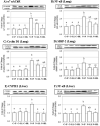Tobacco carcinogen induces both lung cancer and non-alcoholic steatohepatitis and hepatocellular carcinomas in ferrets which can be attenuated by lycopene supplementation
- PMID: 27116542
- PMCID: PMC5085066
- DOI: 10.1002/ijc.30161
Tobacco carcinogen induces both lung cancer and non-alcoholic steatohepatitis and hepatocellular carcinomas in ferrets which can be attenuated by lycopene supplementation
Abstract
Early epidemiologic studies have reported that tobacco smoking, which is causally associated with liver cancer, is an independent risk factor for non-alcoholic fatty liver diseases (NAFLD). Lycopene from tomatoes has been shown to be a potential preventive agent against NAFLD and hepatocellular carcinoma (HCC). In the present study, we investigated whether the tobacco carcinogen 4-(N-methyl-N-nitrosamino)-1-(3-pyridyl)-1-butanone (NNK) induces lesions in both lungs and livers of ferrets with or without lycopene intervention. Male ferrets (6 groups, n = 8-10) were treated either with NNK (50 mg/kg BW, i.p., once a month for four consecutive months) or saline with or without dietary lycopene supplementation (2.2 and 6.6 mg/kg BW/day, respectively) for 26 weeks. Results demonstrate that NNK exposure results in higher incidences of lung tumors, HCC and steatohepatitis (which is characterized by severe inflammatory cell infiltration with concurrent fat accumulation in liver, hepatocellular ballooning degeneration and increased NF-κB expression), as well as elevations in bilirubin and AST levels in ferrets. Lycopene supplementation at two doses prevented NNK-induced expressions of α7 nicotinic acetylcholine receptor in the lung and NF-κB and CYP2E1 in the liver and attenuated the NNK-induced mortality and pathological lesions in both the lungs and livers of ferrets. The present study provided strong experimental evidence that the tobacco carcinogen NNK can induce both HCC and steatohepatitis in the ferrets and can be a useful model for studying tobacco carcinogen-associated NAFLD and liver cancer. Furthermore, lycopene could provide potential benefits against smoke carcinogen-induced pulmonary and hepatic injury.
Keywords: ferret; liver cancer; lycopene; steatohepatitis; tobacco carcinogen.
© 2016 UICC.
Figures




References
-
- Maser E. Significance of reductases in the detoxification of the tobacco-specific carcinogen NNK. Trends Pharmacol Sci. 2004;25:235–7. - PubMed
-
- Grando SA. Connections of nicotine to cancer. Nat Rev Cancer. 2014;14:419–29. - PubMed
-
- Hecht SS, Chen CB, Ohmori T, Hoffmann D. Comparative carcinogenicity in F344 rats of the tobacco-specific nitrosamines, N′-nitrosonornicotine and 4-(N-methyl-N-nitrosamino)-1-(3-pyridyl)-1-butanone. Cancer Res. 1980;40:298–302. - PubMed
MeSH terms
Substances
Grants and funding
LinkOut - more resources
Full Text Sources
Other Literature Sources
Medical

